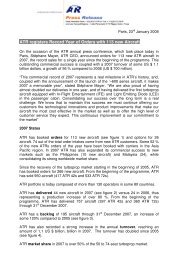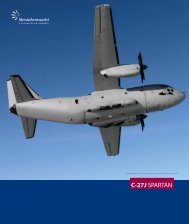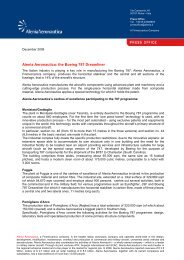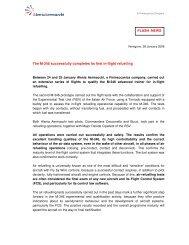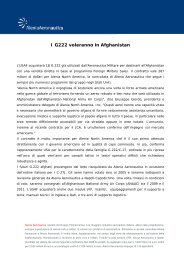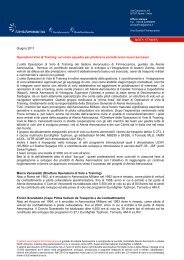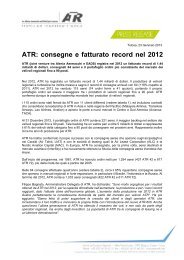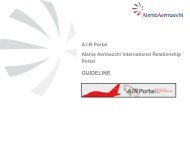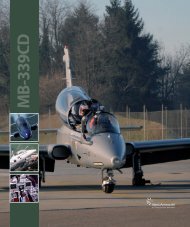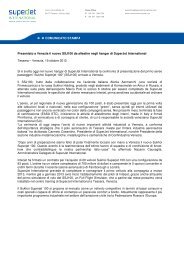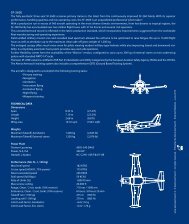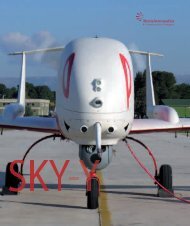C_27J Pocket 7_06.qxp - Alenia Aermacchi
C_27J Pocket 7_06.qxp - Alenia Aermacchi
C_27J Pocket 7_06.qxp - Alenia Aermacchi
You also want an ePaper? Increase the reach of your titles
YUMPU automatically turns print PDFs into web optimized ePapers that Google loves.
Spartan<br />
The TheSmart Choice...<br />
for foraaTrue Military Airlifter<br />
<strong>Pocket</strong> <strong>Pocket</strong> Technical Guide Guide
The material presented in this publication is provided to acquaint you<br />
with the general characteristics of our product. It is not an offer and does<br />
not constitute a commitment, a warranty or representation.<br />
The detail type specification, which is part of the purchase agreement,<br />
will define the final configuration and capabilities of the product.<br />
© <strong>Alenia</strong> Aeronautica - All rights reserved<br />
Photos by <strong>Alenia</strong> Aeronautica except as noted:<br />
Aeronautica Militare Italiana: pages 4 and 5
INDEX<br />
The C-<strong>27J</strong> Spartan . . . . . . . . . . . . . . . . . . . . . . . . . . . . . 03<br />
Introduction . . . . . . . . . . . . . . . . . . . . . . . . . . . . . . . . . . 04<br />
General characteristics . . . . . . . . . . . . . . . . . . . . . . . . . . 06<br />
Cargo capabilities . . . . . . . . . . . . . . . . . . . . . . . . . . . . . 08<br />
Loadability . . . . . . . . . . . . . . . . . . . . . . . . . . . . . . . . . . . 10<br />
Drive on/off - Vehicle & Equipment . . . . . . . . . . . . . . . . . 13<br />
Operational capability . . . . . . . . . . . . . . . . . . . . . . . . . . . 14<br />
Performance . . . . . . . . . . . . . . . . . . . . . . . . . . . . . . . . . 16<br />
Systems . . . . . . . . . . . . . . . . . . . . . . . . . . . . . . . . . . . . 20<br />
Reconfiguration time . . . . . . . . . . . . . . . . . . . . . . . . . . . 32<br />
Program schedule . . . . . . . . . . . . . . . . . . . . . . . . . . . . . 32<br />
Highlights . . . . . . . . . . . . . . . . . . . . . . . . . . . . . . . . . . . 33<br />
Comparison . . . . . . . . . . . . . . . . . . . . . . . . . . . . . . . . . . 34<br />
Cargo hold optimized for military loads . . . . . . . . . . . . . . 36<br />
Survivability features . . . . . . . . . . . . . . . . . . . . . . . . . . . 38<br />
Supportability features . . . . . . . . . . . . . . . . . . . . . . . . . . 40
The C-<strong>27J</strong> Spartan<br />
Conceived for the military role since its original design, the<br />
C-<strong>27J</strong> is the only true tactical military airlifter in its class.<br />
> Loading capability at the top of its class<br />
> High performance/assault capability<br />
> Excellent manoeuvrability and handling qualities<br />
> All weather day/night mission capability<br />
> Modern cockpit and outstanding avionics<br />
> Autonomous operations from/to unprepared remote fields<br />
> Minimum ground support for loading /unloading<br />
> High Survivability<br />
> Civil & Military certification<br />
> Military Specification Standard (MIL) design<br />
> Flexible and versatile platform suited for special variants<br />
> C-130J commonality<br />
> Interoperability with heavier airlifters<br />
> World-wide highly responsive support<br />
> Low life-cycle costs<br />
> Built-in growth capability to meet specific customer<br />
requirements<br />
3
Introduction<br />
Evolution of the scenario<br />
> Modifing obsolete military assets conceived to counter<br />
potential well localized and monolithic threats has been<br />
the main target for the ‘90s. Armed forces are changing<br />
towards a more flexible and lean system able to face a<br />
wide number of less predictable and asymmetric threats.<br />
> New strategic and operational scenarios give increasing<br />
importance to surveillance, intelligence and mobility<br />
especially for out of area and peace support operations.<br />
> Much greater priority has been given to airlift to ensure<br />
a most effective and rapid deployment.<br />
> World military transport fleets are largely obsolete and<br />
inefficient; their replacement can’t be postponed any<br />
longer.<br />
> Increasing operational needs and limited military budgets<br />
demand an affordable military airlifter that ensures:<br />
. Low acquisition and O&S costs,<br />
. Excellent operational capabilities,<br />
. High flexibility,<br />
. Interoperability.<br />
4
The C-<strong>27J</strong> program<br />
The C-<strong>27J</strong> is designed to provide a superior military tactical airlift<br />
capability and represents the best and most technologically<br />
advanced solution to meet the most demanding military<br />
requirements.<br />
It can airlift troops, supplies, vehicles, equipment and<br />
injured personnel as well as airdrop paratroops, materiel<br />
and equipment from/to remote unprepared fields.<br />
The C-<strong>27J</strong> is extremely rugged and offers the most modern<br />
features that allow it to perform a full range of missions<br />
effectively, efficiently and reliably, with a high degree of<br />
survivability.<br />
Low operating cost and high versatility make the aircraft an<br />
affordable and smart answer for the operators.<br />
Avionics and Propulsion systems developed by Lockheed<br />
Martin with full C-130J commonality.<br />
81 aircraft ordered by Italian, Hellenic, Bulgarian, Lithuanian,<br />
Romanian, Moroccan Air Forces and by US Air National Guard.<br />
The C-<strong>27J</strong> JCA Team, composed by L-3 Communications<br />
Integrated Systems (as prime contractor), <strong>Alenia</strong><br />
Aeronautica, <strong>Alenia</strong> North America and Global Military<br />
Aircraft Systems (GMAS), has been contracted to offer<br />
the C-<strong>27J</strong> as the best value solution to meet the requirements<br />
of the U.S. Government Joint Cargo Aircraft (JCA) program.<br />
5
General characteristics<br />
Three view - Dimensions<br />
12.40 m<br />
(40.68 ft)<br />
28.70 m<br />
(94.16 ft)<br />
3.56 m<br />
(11.68 ft)<br />
9.64 m<br />
(31.65 ft)<br />
6.38 m (20.93 ft)<br />
22.70 m<br />
(74.47 ft)<br />
Diameter 4.11 m<br />
(13.48 ft)<br />
6
Wing area<br />
82 sq.m<br />
Aspect Ratio 10<br />
Weights<br />
2.25g 2.5g 3g<br />
(Logistic) (Basic) (Assault)<br />
> MTOW (kg) 31,800 30,500 30,500<br />
(lb) 70,107 67,241 67,241<br />
> Max Payload (kg) 11,100 8,600 8,100<br />
(lb) 24,471 18,960 17,857<br />
MLW:<br />
> (maximum @ 6 fps)<br />
> (normal @ 10 fps)<br />
30,500 kg<br />
27,500 kg<br />
(67,241 lb)<br />
(60,627 lb)<br />
Fuel Weight:<br />
> fuel density @ 0.79 kg/l) 9,734 kg<br />
> (fuel density @ 6.59 lb/gallon) 21,460 lb<br />
Propulsion<br />
> Engines:<br />
> Take off Rating:<br />
> Propellers:<br />
> Diameter:<br />
Two Rolls Royce AE 2100D2A<br />
4,637 SHP<br />
Two Dowty R391/6-132-F/10 Six-Blade<br />
13.5 ft<br />
Minimum Crew<br />
> 2 Pilots<br />
7
Cargo capabilities<br />
Cargo bay dimensions<br />
2.60 m<br />
2.25 m<br />
2.45 m<br />
3.33 m<br />
2.25 m<br />
8.58 m<br />
0.90 m 1.95 m<br />
2.45 m<br />
11.43 m<br />
8
Compartments<br />
C D E F G H I L M N O<br />
Max Load Capac.<br />
of Compartment<br />
KG<br />
LB<br />
3580 4980 4980 4980<br />
7894 10981 10981 10981<br />
4260 5700 4960 5552 3060 2460 2210<br />
8393 12569 10981 12242 6747 5423 4873<br />
Max Superficial<br />
Load on Floor<br />
KG/M 2 2000 2000 2000<br />
LB/FT 2 410 410 410<br />
2000<br />
410<br />
2000 2000 2000 2000 2000 1000 1000<br />
410 410 410 410 410 205 205<br />
Max Load per<br />
Floor Length Unit<br />
KG/M 4900 4900 4900 4900 4900 4900 4900 4900 4900 2400 2400<br />
LB/FT 3290 3290 3290 3290 3290 3290 3290 3290 3290 1511 1511<br />
Max Load per Floor Length Unit is constant along the<br />
fuselage providing high flexibility for loading operations.<br />
9
Loadability<br />
Troops and paratroops<br />
46 equipped paratroopers<br />
(standard 20” wide seats)<br />
Up to 60 troops can be<br />
accommodated in high density<br />
configuration (option)<br />
Medevac<br />
36 standard NATO stretchers<br />
(STANAG 2040) with dedicated<br />
oxygen port + 6 attendant seats<br />
10<br />
Dedicated pressurization schedule for high comfort
Container delivery<br />
6 A22 CDS Bundles<br />
on a single row<br />
Up to 12 A22 CDS Bundles<br />
on two parallel rows (by removing<br />
the cargo handling system)<br />
Pallets<br />
463L std military pallets<br />
3 (88”x108”) HCU-6/E +<br />
1 (88”x54”) HCU-12/E<br />
11
Options - V.I.P. Configuration<br />
Up to 6 VIPS + 18 escort passengers and a service module<br />
with commercial type equipment mounted on quicky installable<br />
(removable) standard military pallets.<br />
12
Drive on/off<br />
Vehicle & equipment<br />
Variable Height/Straight-On-Loading<br />
(M-101 ~ 105mm Howitzer)<br />
Variable Attitude/Drive-On-Loading<br />
(AML-90 / HMMWV)<br />
Fighter Engine<br />
(M53-Mirage 2000)<br />
13
Operational capability<br />
The C-<strong>27J</strong> offers significantly more capability than any alternative<br />
aircraft in its class. Its large flight envelope allows it to carry<br />
out the most demanding tactical missions quickly, safely and<br />
effectively.<br />
Material Airdrop<br />
The aircraft can airdrop up to 9 tons of materiel:<br />
6 tons single platform (HCU-6/E);<br />
9 tons two/three platforms (HCU-6/E);<br />
up to 5 tons through LAPES;<br />
up to 6 tons through combat off load.<br />
Autonomous Operation<br />
The aircraft is designed to operate on field with no support<br />
equipment:<br />
The APU provides the aircraft with an independent power<br />
source.<br />
Two 40 Ah batteries<br />
Adjustable cargo floor height and inclination for easy and fast<br />
loading/unloading procedures with no external support.<br />
The aircraft can operate to/from austere unprepared strips:<br />
Excellent STOL capability.<br />
High steep descent profile (dedicated flight idle rating).<br />
Optimum adaptive anti-skid braking system.<br />
High flotation gear (CBR 4 or less)<br />
High wheel steering (up to 65° angle).<br />
14
All Weather / Day Night<br />
The aircraft can operate in all weather conditions, day and<br />
night:<br />
> Precise navigation system (GPS) in conjunction with the<br />
radar and digital map.<br />
> NVIS (Night Vision Imaging System) compatible cockpit.<br />
> NVIS compatible External & internal lighting.<br />
> Head Up Display (option).<br />
15
Performance<br />
Farther and Faster<br />
The C-<strong>27J</strong> features the best performance in its class:<br />
> 2,000 nm with 6,000 kg of Payload<br />
> 3,100 nm ferry flight<br />
> Maximum Cruise Speed 315 KTAS @ 95% MTOW<br />
> Cruise Altitude up to 30,000 ft<br />
> Outstanding ground performance: 580 m T/O ground run<br />
@ MTOW and 340 m landing roll @ MLW<br />
16
12,000<br />
10,000<br />
8,000<br />
2.25 g<br />
2.5 g<br />
3 g<br />
C-<strong>27J</strong> PAYLOAD RANGE<br />
Engine AE2100D2A<br />
Fuel Reserve<br />
Holding 45' at 5000 ft<br />
6,000<br />
4,000<br />
2,000<br />
0<br />
0 500 1,000 1,500 2,000 2,500 3,000 3,500<br />
Range (nm)<br />
Ground Run (m)<br />
TACTICAL TAKEOFF - GROUND RUN<br />
HARD RUNWAY @ ISA Condition, S.L.<br />
1,000<br />
900<br />
800<br />
700<br />
600<br />
500<br />
400<br />
300<br />
200<br />
100<br />
0<br />
20,000 22,000 24,000 26,000 28,000 30,000 32,000<br />
Takeoff Weight (kg)<br />
17
Ground Roll (m)<br />
1,000<br />
900<br />
800<br />
700<br />
600<br />
500<br />
400<br />
300<br />
200<br />
100<br />
TACTICAL LANDING - GROUND ROLL<br />
HARD RUNWAY - FULL REVERSE @ ISA Condition, S.L.<br />
0<br />
20,000 22,000 24,000 26,000 28,000 30,000 32,000<br />
Landing Weight (kg)<br />
35,000<br />
OPERATIVE CEILING<br />
ISA condition<br />
Altitude (ft)<br />
30,000<br />
25,000<br />
20,000<br />
15,000<br />
10,000<br />
All Engine Operative<br />
One Engine Out<br />
5,000<br />
Rating max continuous<br />
0<br />
20,000 22,000 24,000 26,000 28,000 30,000 32,000<br />
Weight (kg)<br />
18
35,000<br />
MAX CRUISE SPEED<br />
ISA - 95 % MTOW<br />
Altitude (ft)<br />
30,000<br />
25,000<br />
20,000<br />
15,000<br />
10,000<br />
5,000<br />
Flap: UP<br />
0<br />
250 260 270 280 290 300 310 320 330<br />
Max Speed (KTAS)<br />
30,000<br />
FLOTATION CAPABILITY<br />
Unpaved Surface @ CBR 4<br />
Take-Off Weight (kg)<br />
28,000<br />
26,000<br />
24,000<br />
22,000<br />
20,000<br />
18,000<br />
C-<strong>27J</strong> Tires<br />
Main tire: 39x13<br />
Nose tire: 29x11<br />
16,000<br />
1 10 100 1,000<br />
Number of Passes<br />
19
Systems<br />
Avionics<br />
The C-<strong>27J</strong> includes a state-of-the-art suite of off-the-shelf<br />
military equipment integrated with a redundant MIL-STD-1553B<br />
digital data bus architecture.<br />
The avionics, directly derived from the C-130J, represents the<br />
most advanced system available in tactical airlifters and is<br />
compatible with the emerging Future Air Navigation System (FANS)<br />
requirements.<br />
Growth capability to satisfy specific customer needs is available.<br />
Communication<br />
> 2 or 4 ARC-210 VHF/UHF radios,<br />
> 1 HF radio with voice and data link capability,<br />
> 1 INMARSAT SATCOM with voice and data link capability,<br />
> 1 VHF/UHF Direction Finder (DF),<br />
> Digital Audio Inter-Communication System (ICS),<br />
> Secure Voice (option).<br />
Navigation<br />
><br />
><br />
><br />
><br />
><br />
><br />
><br />
><br />
><br />
Dual redundant Flight Management System,<br />
2 Embedded GPS/INS with Precise Positioning Service (PPS)<br />
(*) and Selective Availability Anti-Spoofing Module (SAASM)(*),<br />
2 TACAN (DME),<br />
2 VOR/ILS/MB,<br />
Low Frequency ADF,<br />
2 Distributed Air Data Systems (DADS),<br />
Dual Radar Altimeter,<br />
Terrain Awareness Warning System (TAWS)<br />
(Aural and Visual Special Alerts),<br />
Digital Map (option).<br />
20
Radar System<br />
Northrop Grumman AN/APN-241 Low Power Colour Radar<br />
(LPCR) with the following modes of operation:<br />
><br />
><br />
><br />
><br />
><br />
Other Equipment<br />
><br />
><br />
><br />
><br />
><br />
><br />
><br />
Monopulse Ground Mapping with Doppler Beam Sharpening,<br />
Weather and Turbulence Detection,<br />
Air Target Detection,<br />
Windshear Detection,<br />
Beacon mode for drop-zone identification.<br />
2 Digital Autopilot – Flight Director Systems with autothrottle,<br />
Identification Friend or Foe (IFF) Transponder with Modes<br />
I and II and Enhanced Mode S (option: Mode 4)(*),<br />
Traffic Alert and Collision Avoidance System (TCAS) -<br />
II (Aural and Visual Identification),<br />
Recording Systems (FDR, CVR, DS-DTU),<br />
5 Colour Multipurpose Display Units (CMDU),<br />
2 Multifunction Control & Display Units (MCDU) with<br />
Automatic dependent surveillance –<br />
Addressed (ADS-A) functionality,<br />
2 Head Up Displays (HUD) (option).<br />
Note (*): subject to specific US and National Government approval.<br />
Main Instrument Panel<br />
1 2 6 7 3 4 5<br />
1 5 Primary Flight Display<br />
2 4 Navigation Display<br />
3 Engine/Warning Display<br />
6 Stand-by instrument<br />
7 Autopilot/Flight Director Control Panel<br />
21
22<br />
Propulsion<br />
> Rolls Royce AE 2100D2A Turboprop Engines.<br />
. High Power, up to 4,637 SHP.<br />
. Low Fuel Consumption.<br />
> Dowty R-391-6-132-F/10 propeller system.<br />
. Six-blade all composite construction.<br />
. 13,5 ft blade diameter.<br />
> Full Authority Digital Electronic Control (FADEC) through<br />
a MIL-STD-1553 Data Bus.<br />
> Propeller control integrated within engine FADEC.<br />
> GKN WESTLAND modern, low drag, fail safe nacelle<br />
design.<br />
> Removal and Replacement time for engine and propeller<br />
assembly: less than 8 hrs.<br />
> Exterior Noise.<br />
. Fly-over full power 88dB.<br />
. Sideline<br />
89dB.<br />
. Approach 95dB.<br />
Complies with<br />
ICAO Annex 16
APU<br />
> Auxiliary Power APS1000 Model T-62T-46C16<br />
manufactured by Hamilton Sundstrand Power<br />
Systems.<br />
> Mechanical 150 HP class.<br />
> APU makes the aircraft completely independent from<br />
external ground support.<br />
> Spool compressor and turbine fully contained.<br />
> Fully operable and reliable in the entire flight envelope.<br />
> Engine starting capability up to 22,000 ft altitude also<br />
in hot weather conditions.<br />
> Easy maintainability and supportability.<br />
Certified According to<br />
JAR 25 and JAR APU<br />
TSO C77a JAR<br />
23
Landing gear<br />
> Independent Nose and main landing gear trailing arm<br />
configuration allows a good flotation capability on strips<br />
with CBR as low as 2.<br />
> The landing gear allows variation of cargo floor<br />
height (0.5 m) and inclination (4.3°).<br />
> Landing sink rate up to 12 ft/sec.<br />
> Digital full adaptive anti-skid system.<br />
> Main Landing Gear composed by two bogies with two<br />
tandem wheels each per side of the aircraft.<br />
. Main gear tire size: 39”x13”.<br />
. Main landing gear shock absorbers, actuators<br />
and sensors housed inside sponsons.<br />
> Nose gear composed by a single axle bogie with two<br />
wheels.<br />
. Nose gear tire size: 29”x11”.<br />
. Nose landing gear is provided with door<br />
mechanism connected with L.G.<br />
Main Landing Gear<br />
24<br />
Complies with<br />
JAR 25.721, JAR 25.723,<br />
JAR 25.725, JAR 25.729,<br />
JAR 25.745, JAR 25.1306
Environmental<br />
Pressurization / Air Conditioning<br />
> The Cabin Pressure Control System guarantees sea<br />
level pressure up to 13,250 ft flight altitude and a<br />
differential pressure of 5.8 psi up to 30,000 ft.<br />
> The Air Conditioning system comprises a simple cycle<br />
system with low pressure water separation, without recirculation.<br />
The system digitally controls temperature in<br />
two cabin zone - cargo and cockpit - with manual backup.<br />
Fire Protection<br />
> Fire and overheat detection in the two nacelles, fire<br />
detection in the APU compartment.<br />
> Fire extinguishing system in the two nacelles and APU<br />
compartment.<br />
> Cargo compartment smoke detection (including a<br />
separate detector in the lavatory).<br />
> Three portable bottle fire extinguishers (1 in the cockpit<br />
and 2 in the cargo compartment).<br />
Ice Protection<br />
> System is state-of-the-art pneumatic boots and electrical<br />
windshields with digital dual channel controller. It<br />
completely protects the wing, vertical, horizontal<br />
stabilisers, engine air intakes and propellers.<br />
Oxygen<br />
> 10 lt converter for flight deck with 3 distribution points.<br />
. Up to 14.5 hrs for 3 members crew @ 25,000 ft.<br />
> 2x10 lt converters for passenger compartment with 46+1<br />
distribution points.<br />
. Up to 2.5 hrs for 46 troops @ 25,000 ft.<br />
> 5 emergency oxygen cylinders<br />
Conform to<br />
MIL-D-19326H<br />
25
Electrical<br />
> 60 KVA, 115/200 VAC, 400 Hz EPGS capacity.<br />
> Three independent generators (two primaries and one<br />
APU) with the same capacity.<br />
> DC power through three 350 A Transformer Rectifier<br />
Units (TRU).<br />
> Two 24 volts 40 Ah, 20 Cells Ni-Cd batteries: one<br />
dedicated to emergency system and one shared between<br />
emergency system and APU starting system.<br />
> System accepts DC and AC external power.<br />
> With two fully operational generators the system is capable<br />
of producing 50% of additional power, beyond the<br />
maximum power required for a night combat mission in<br />
ice condition (without performance degradation).<br />
50/60 kVA<br />
50/60 kVA<br />
50/60 kVA<br />
AC<br />
Gen 1<br />
DC Ext Pwr<br />
AC Ext Pwr<br />
APU<br />
Gen<br />
AC<br />
Gen 2<br />
AC Bus 1 AC Bus 2<br />
Tru<br />
1<br />
26Vac Bus1<br />
Stby<br />
Tru<br />
26VAC Bus2<br />
Tru<br />
2<br />
DC Bus 1<br />
DC Bus 2<br />
DC Emer<br />
Bus<br />
Hot Emer<br />
Bat Bus<br />
Emergency<br />
Battery<br />
APU Starting Bus<br />
M<br />
APU Starter<br />
DC Essen Bus<br />
Hot Apu Bat<br />
Bus<br />
APU Syart<br />
Battery<br />
26<br />
Conform to MIL-STD-704
Hydraulic<br />
> Two fully independent 3,000 psi systems.<br />
. Each engine drives one system.<br />
. Each system provided with an Engine Driven<br />
Pump (EDP 50 lt/min) and an AC Electrical Motor<br />
Pump (ACMP 25 lt/min).<br />
. Both ACMP’s can be powered by APU generator.<br />
> In case of failure of one of the two hydraulic systems,<br />
the other is able to provide all the hydraulic power demand.<br />
> All the critical Items are double provided by the two<br />
systems.<br />
SYSTEM N.1<br />
RESERVOIR<br />
SYSTEM N.2<br />
RESERVOIR<br />
ENG. 1<br />
50 lt/min<br />
GEN. 2<br />
AC<br />
FLAPS<br />
RUDDER<br />
ELEVATOR<br />
SPOILERS<br />
50 lt/min<br />
ENG. 2<br />
GEN. 1<br />
AC<br />
25 lt/min 25 lt/min<br />
LANDING GEAR<br />
DOOR & RAMP<br />
L/G ATTITUDE VAR.<br />
LIFT DUMPER<br />
WHEEL BRAKES<br />
PARK / EMER NORMAL<br />
STEERING<br />
Conform to:<br />
MIL-H-5440, MIL-H-5606<br />
MIL-C-25427A, QPL-L-85762A<br />
27
Fuel<br />
> Four independent wing tanks with cross-feed capability.<br />
> Two independent fuel feeding systems.<br />
. Two electrically driven pumps for each tank.<br />
. Independent engine fuel feeding systems.<br />
> Single point pressurised refuelling and four points gravity<br />
refuelling.<br />
> Defuelling at the centralised refuelling point.<br />
> Fuel jettison operates throughout flight envelope, nominal<br />
jettison flow rate is 266 kg/min.<br />
> AAR probe for in-flight refuelling as an option.<br />
> On Board Inert Gas Generating System (OBIGGS).<br />
Fuel Tank Capabilities<br />
Fuel Tank Gallons Litres<br />
2 Main wing Tanks 1,775 6,720<br />
2 Auxiliary Wing Tanks 1,480 5,600<br />
Total Capacity 3,255 12,320<br />
28<br />
Conform to:<br />
MIL-T-5264<br />
MIL-T-83133<br />
ASTM D 1655
Flight control<br />
> Conventional type all mechanical control system.<br />
> Fully powered elevators, state of the art Q-Feel System<br />
controlled by digital control unit.<br />
> Disconnection between two loops by Jamming Override<br />
Mechanism (JOM).<br />
> Hydraulic Rudder/Rudder Trim control .<br />
> Automatic rudder travel limitation as a function of aircraft<br />
speed, controlled by a digital unit.<br />
> Flight control system integrated with avionics.<br />
. State of the art digital stall warning system.<br />
. Digital Autopilot.<br />
. Take-off configuration warning implemented.<br />
29
Lighting<br />
> External lighting system.<br />
. Three operational modes for anti-collision and<br />
navigation lights: Normal, Covert (IR) and NVIS<br />
compatible.<br />
. Two operational modes for landing, taxing,<br />
formation and wing inspection lights: Normal and<br />
Covert.<br />
> Internal lighting system NVIS compatible.<br />
. Cockpit lights:<br />
- two dome, two flood and two utility lights,<br />
- ability to full dim cockpit lights,<br />
- thunderstorm mode.<br />
. Cargo area lights:<br />
- 16 dome and 10 floor lights.<br />
. Night vision goggle mode available.<br />
. Emergency lighting.<br />
30<br />
Conform to:<br />
MIL-L-006730, MIL-L-85762<br />
MIL-L-6503, QPL-7788-77
Equipment - Furnishings<br />
> Seats :<br />
. crew seats according with MIL-S-25073,<br />
. troop/paratroop according with MIL-S-27184B.<br />
> Two independent retrieval winch for paratrops with remote control.<br />
> Cargo winch for loading/unloading procedures.<br />
> Electrical flushing toilet located inside the lavatory.<br />
> Galley equipment with a hot cup: 0.85 l<br />
capacity, located inside the lavatory (option).<br />
> Drinking water containers and dispensers: 22 l capacity.<br />
> Emergency equipment.<br />
> Thermal / acoustical panels composed by primary and<br />
secondary blankets.<br />
Self protection (option)<br />
> Radar Warning Receiver.<br />
> Missile Warning System.<br />
> Laser Warning Receiver.<br />
> Countermeasures dispensing system (chaff & flares).<br />
> Ballistic protection.<br />
31
Reconfiguration time<br />
Configuration changes achieved with Operational Kits<br />
installed & stowed on the aircraft for rapid & easy<br />
reconfiguration away from base.<br />
Reconfigured in Flight<br />
by One Loadmaster<br />
Without Assistance<br />
Time in<br />
minutes<br />
All Equipment Stowed<br />
Troop Transport<br />
Paratroops Airdrop<br />
Material Transport<br />
Material Airdropping<br />
Medical Evacuation<br />
All Equipment Stowed<br />
6<br />
23<br />
10<br />
29<br />
25<br />
Troop Transport<br />
6<br />
17<br />
15<br />
35<br />
27<br />
Paratroops Airdrop<br />
23<br />
17<br />
30<br />
25<br />
44<br />
Material Transport<br />
10<br />
15<br />
30<br />
22<br />
32<br />
Material Airdropping<br />
29<br />
35<br />
25<br />
22<br />
48<br />
Medical Evacuation<br />
25<br />
27<br />
44<br />
32<br />
48<br />
Program schedule<br />
32<br />
> Program Launch: June, 1997<br />
> First Flight: September, 1999<br />
> Full Civil and Military Certification: June/December, 2001<br />
> Additional Certification for new Specific Customer Required.<br />
> Contracts: Italian Air Force - June 2002<br />
Hellenic Air Force - January 2003<br />
Bulgarian Air Force - February 2006<br />
Lithuanian Air Force - June 2006<br />
US Air National Guard - June 2007<br />
Romanian Air Force - December 2007<br />
Moroccan Air Force - August 2008<br />
> In service since: September 2005
Highlights<br />
48 months from Go Ahead to Certification<br />
81 aircraft ordered<br />
31 aircraft delivered<br />
Already in operation with Hellenic, Italian, Lithuanian,<br />
Bulgarian, Romanian and Moroccan Air Forces and with<br />
US Air National Guard<br />
12 aircraft on production.<br />
The production build-up rate is set up to satisfy all<br />
Customer needs and to introduce the aircraft in the<br />
Customer inventory with no-risk of matching the required<br />
delivery schedule.<br />
33
Comparison<br />
True Military Platform<br />
A military load has a high weight distributed on a small<br />
space. The floor strength is the best index to divide a real<br />
military aircraft from a civil aircraft.<br />
The C-<strong>27J</strong> is a True Military Airlifter<br />
Floor Strength per Unit Length (kg/m)<br />
8,000<br />
7,000<br />
6,000<br />
True Military Transport Aircraft<br />
A400M<br />
5,000<br />
C-130-30 C-141<br />
4,000<br />
family<br />
3,000<br />
C-<strong>27J</strong><br />
C-130<br />
family<br />
2,000<br />
Derivative from Civil Aircraft<br />
1,000 ATR 42<br />
ATR 72 CN-235 C-295<br />
0<br />
150 200 250 300 350 400 450 500 550<br />
Payload / Floor Area (kg/sq.m)<br />
A high percentage of equipment loading capacity makes<br />
the Airforce fleet mix more flexible and efficient. The C-<strong>27J</strong><br />
completes up to 70% of the missions for a typical airborne<br />
division deployment.<br />
34
100%<br />
The C-<strong>27J</strong> deploys up to 70% of the<br />
Typical Airborne Division Equipment<br />
80%<br />
Heavier Military<br />
Transport a/c<br />
Equipment loading capacity<br />
60%<br />
40%<br />
C-<strong>27J</strong><br />
20%<br />
Different Choices<br />
Derivative from Civil a/c<br />
0%<br />
0 500 1,000<br />
1,500<br />
Floor strength (kg/m of axial load)<br />
35
Cargo hold optimized<br />
for military loads<br />
Why not!<br />
Sometimes it is very important to carry an unusual load.<br />
Who can do it<br />
C-130<br />
C-<strong>27J</strong><br />
CN235<br />
C295<br />
AN 32<br />
Bell-206<br />
Cabin Dimensions<br />
More cabin volume and width makes any load/unload<br />
operation easier and faster.<br />
Cabin Dimensions C-<strong>27J</strong> C-130J C295 CN235 AN32<br />
Max Width (m) 3.33 4.16 2.7 2.7 2.78<br />
Max Height (m) 2.60 2.74 1.90 1.90 1.84<br />
Floor Area (Excl. Ramp) (sqm) 23.23 36.94 29.95 22.77 27.96<br />
Cabin Volume (Excl. Ramp) (cm) 69.48 124.90 56.48 43.08 57.91<br />
36
Door Location & Dimensions<br />
> The height of the in-flight operable doors allows an easier and<br />
safer paratroop operation.<br />
> The hatches are the best escape way in case of ditching.<br />
CN235<br />
Doors Location C-<strong>27J</strong> C-130J<br />
AN32<br />
C295<br />
48" x 29"<br />
Left FWD (HxW) 59" x 26"<br />
36" x 20" 55" x 24"<br />
45" x 30" (FD)<br />
Right FWD (HxW) 40" x 21" (ED) 48" x 29" 50" x 28" (ED) NO<br />
Left AFT (HxW) 76" x 36" (OIF) 72" x 36" (OIF) 69" x 35" (OIF) 20" x 24" (ED)<br />
Right AFT (HxW) 76" x 36" (OIF) 72" x 36" (OIF) 69" x 35" (OIF) 20" x 24" (ED)<br />
Ramp & cargo door<br />
(HxW) 89" x 96" 108" x 120" 67" x 93" 59" x 91"<br />
(cross section)<br />
(OIF)<br />
(OIF)<br />
(OIF)<br />
(OIF)<br />
Cockpit Escape Hatch (qty) 1 1 NO 1<br />
Cabin Escape Hatch (qty) 2 2 NO NO<br />
(ED) Emergency Door; (OIF) Operable In-Flight; (FD) Flight Deck<br />
37
Survivability features<br />
Designed for harsh operations, the C-<strong>27J</strong> features<br />
redundant systems, Mil-Spec design, and built-in self<br />
protection provisions.<br />
The C-<strong>27J</strong> military design includes the following integrated<br />
features for combat survivability:<br />
> Damage Tolerance.<br />
. All critical systems are redundant (hydraulic,<br />
electrical, ADS, avionics, displays and controls).<br />
. Redundant load paths.<br />
. Three-spar construction (wing and empennage).<br />
. Oxygen masks permit flying at high altitudes in<br />
case of depressurization.<br />
. Fuel jettison capability.<br />
. Emergency landing gear extension.<br />
. OBIGGS, anti-deflagration fuel tanks.<br />
> High Power-to-Weight Ratio.<br />
. Rapid acceleration/deceleration (2 kts/sec).<br />
. Rapid climb capability (
Superior outstanding tactical manoeuvrability.<br />
. Low stall speed (80 to 90 kts).<br />
. Low level flight to avoid detection.<br />
. High roll rate (45/sec @ 180 kts).<br />
. Tight turn radius (500 m, 2.5g sustained @ 180<br />
kts).<br />
. 3.0g<br />
capability<br />
. 4,000 ft per min descent rate.<br />
><br />
><br />
><br />
Excellent visibility through 16 cockpit windows.<br />
In-flight operable auxiliary power unit (APU).<br />
Navigation System.<br />
. Modern avionics.<br />
. Redundant communications.<br />
Optional self protection devices and use of redundant and<br />
segregate systems reduce the aircraft vulnerability when it is<br />
engaged by hostile weapon systems.<br />
39
Tailored and effective Integrated Logistic Support (ILS)<br />
is a primar y element of the C-<strong>27J</strong> Program.<br />
• International Support Capability<br />
> Worldwide Customer Support long term experience<br />
> Strategic relationship with aerospace key players as<br />
Honeywell, Rolls Royce and Dowty<br />
> Effective supply chain management<br />
ILS<br />
Management<br />
Training Devices<br />
Customer<br />
Relationship Management<br />
Services<br />
Integrated<br />
Logistic<br />
Support<br />
On Site<br />
Maintenance<br />
Team<br />
Repair &<br />
Overhaul<br />
• C-<strong>27J</strong> Maintainability Highlights<br />
> Extended On-Condition maintenance approach<br />
> Advanced Built-in diagnostic capabilities<br />
> Engine and Structure Health Monitoring<br />
> Streamlined Scheduled Maintenance Program<br />
40
• Integrated Logistic Support<br />
> Customer tailored solutions (logistic supplies and services)<br />
> Prompt Customer Assistance<br />
> Modular and comprehensive Training offer<br />
> Cost-effective Through Life Support approach<br />
Spare Parts Provisioning<br />
and Management<br />
Ground Support<br />
Equipment<br />
Technical<br />
Publications<br />
Aircrew and<br />
Maintenance<br />
Training<br />
Remote<br />
Field Service Representative<br />
Technical Assistance<br />
• Cost Savings<br />
> High Equipment Reliability<br />
> Easy Aircraft Designed-in Maintainability<br />
> Customer executable Maintenance Program, with reduced<br />
Aircraft downtime<br />
> Extended commonality with the C-130J Aircraft for Propulsion<br />
and Avionic Systems<br />
41
Notes
Notes
Notes
Published by <strong>Alenia</strong> Aeronautica - Image and Publishing Department - July 2010<br />
www.alenia.it



